Mirin may not be as familiar to the world as other Japanese condiments like soy sauce or miso, but this frequently used sweet alcoholic liquid seasoning is a must for lovers of Japanese cuisine and those who love experimenting with new ingredients.
In this article, we’ll explain the difference between Hon Mirin and other mirin products available and which ones you should buy for what purpose, how wonderful mirin is to replace sugar or other sweet condiments, as well as introducing you to drinking-grade mirin, including a couple of simple and delicious cocktails for you to try.
And if you’d prefer to try mirin without the alcohol content, there’s an easy fix and options for that too.

Table of Contents
What is Mirin?
The National Tax Agency classifies Hon Mirin (true, traditional mirin) as an alcoholic condiment/seasoning.
Sake, mirin, wine, and other alcoholic beverages are also used as seasonings, but mirin is Japan’s representative alcoholic beverage seasoning. Used in sauces, broths and marinades, it’s hard to come across a Japanese recipe without some reference to mirin.
Its manufacture is dictated by Article 3, Item 11 of the Alcohol Tax Law, which details the permitted ingredients and processing techniques in order to be classified as “mirin”. To be deemed Hon Mirin, it must have an alcohol content of less than 15 percent, have an extract content of 40 percent or more, and meet other requirements specified by Cabinet Order.
Extract content is the amount of non-volatile ingredients (grams in 100ml) that remain after mirin or mirin-like seasoning is heated to evaporate, and mainly includes sugars and amino acids. Generally, the higher the extract content, the stronger and richer the sweetness. In the case of Hon Mirin, more than 40% is extract. We call it Ekisu-bun (エキス分, extract content).
According to the law, the term “mirin” means:
(a) Liquor made by adding shochu (shōchū, a distilled Japanese spirit) or alcohol to rice and rice koji (Aspergillus oryzae or kōji mold) and then filtering it
(b) Rice, rice koji, and shochu or alcohol mixed with mirin or other ingredients specified by a Cabinet Order (namely glucose and mizuame)
(c) Mirin with shochu or alcohol added
(d) Mirin and mirin kasu (mirin lees) added, then filtered
Although the law doesn’t say what kind of rice is to be used in Hon Mirin, many producers mainly use Mochigome (餅米, もちごめ, glutinous rice) and the rice koji is usually made with ordinary non-glutinous rice.
How is Hon Mirin made?
Hon Mirin is generally made by combining:
- Rice (glutinous rice or ordinary non-glutinous rice)
- Rice koji (kōji mold made using non-glutinous rice)
- Shochu or Jozo alcohol (jōzō, brewer’s alcohol)
- And other ingredients specified by a government ordinance
It is then filtered after 40 to 60 days of saccharification and maturation. A producer like Sugiura Mirin will mature it for up to 6 months.
Unlike how sake is made (the sake-making process brews alcohol with multiple parallel fermentation), the process of making mirin does not actually involve brewing any alcohol, rather it is added in the form of Shochu or Jozo alcohol (brewer’s alcohol).
During the process, the starch and protein of the glutinous rice is broken down by the rice koji, and more than 9 different kinds of sugar like glucose, Isomaltose, and Oligo, acids like amino acids, organic acids, and aromatic ingredients are produced, giving the mirin its distinctive flavor.
After filtering, some producers will age their Hon Mirin for between 1 and 20 years. The mirin becomes increasingly brown as it ages as a result of Maillard reaction.
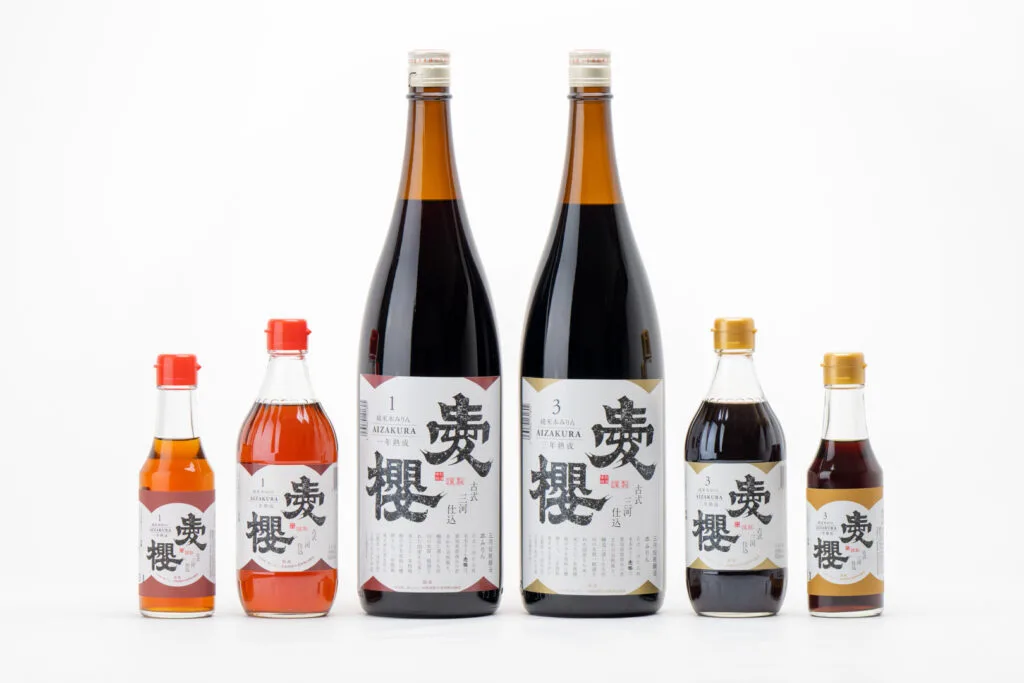
Types of mirin
There are three main types of mirin:
- Hon Mirin (本みりん, ほん・みりん)
- Mirin-fū chōmiryō (みりん風調味料, みりんふう・ちょうみりょう)
- Hakkō (Jōzō) chōmiryō (発酵(醸造)調味料, はっこう (じょうぞう)・ちょうみりょう) Mirin type (みりんタイプ)
Hon Mirin contains alcohol and is considered the “real” and traditional mirin. There is Hon Mirin that is drinkable just like wine or other alcoholic beverages, as well as those that are intended for use in cooking only.
Mirin-fu Chomiryo (a mirin-style seasoning) does not contain much alcohol, and Hakko (Jozo) Chomiryo is a fermented mirin-style seasoning that contains alcohol and salt.
You might think that there are no major differences in flavor, but each has a different cooking effect. There is also a distinction in terms of tax applicability. Alcohol tax applies to Hon Mirin but not Mirin-fu chomiryo and Hakko chomiryo.
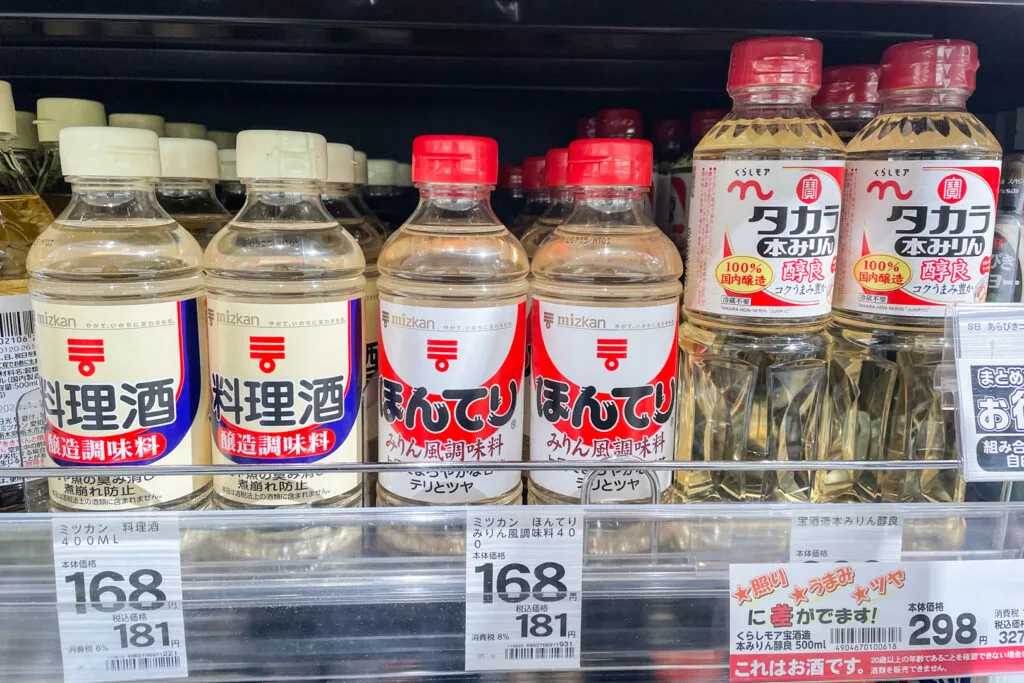
Here are the major differences between them:
| Comparison | Hon Mirin | Mirin-fu Chomiryo | Hakko (Jozo) Chomiryo |
| Alcohol Content | 12.5 – 14.5% | Less than 1% | 8 – 20% |
| Ingredients | Glutinous rice, Koji rice, Shochu or Jozo (brewer’s) alcohol (some producers add additional sweetener) | Mizuame, seasonings, acidity (and others) | Mizuame, Koji rice, salt (and others) |
| Benefit | Maintains the firmness of the ingredients; allows flavors to penetrate well; has an elegant, mild sweetness; and adds richness and flavor. Alcohol tax added so it is pricier than the others. | Don’t need to cook it in advance to remove the alcohol. No alcohol tax is added so the price is cheap. | There are some cooking effects of using alcohol. Even though it contains alcohol, alcohol tax is not added since it is not drinkable because of the added salt. |
| Storage after opening | No need to put it in the refrigerator. After opening it, it’s best to keep it in a cool room. | Need to put it in the refrigerator after opening the bottle. | No need to put it in the refrigerator. After opening it, it’s best to keep it in a cool room. |
Since Hon Mirin and Hakko (Jozo) chomiryo mirin-type contain alcohol, they are effective in removing the smell of raw fish and meat, preventing them from being undercooked, and ensuring that the umami flavors penetrate the food.
On the other hand, when it is used in dishes that are not heated (marinades, dressings), or if kids are eating it, it is necessary to boil it off to remove the alcohol. Mirin-fu chomiryo contains almost no alcohol (less than 1%), so there is no need to boil it down.
If you are going to use Hakko (Jozo) chomiryo, keep in mind that it contains salt so when you cook with it, you need to reduce the amount of salt in the recipe.
Why use Hon Mirin?
I love using Hon Mirin instead of fake mirin for the following reasons. (Sorry to say fake, but Mirin-fu chomiryo and Jozo (Hakko) Chomiryo may be reminiscent of mirin, but they are manufactured in a completely different way and are not actually true mirin in the traditional sense).
1. It has a mild and elegant sweetness
Hon Mirin is composed of many kinds of sugars such as glucose and oligosaccharide. This gives it a mellower sweetness than sugar, which is made up of sucrose.
2. It brings out the “luster” and “shininess” of food
Hon Mirin contains a number of sugars that are effective in adding luster and shine to the surface of food. These sugars form a film on the surface of the ingredients, giving the food a shiny finish and a delicious appearance.
3. Maintains firmness
The sugar and alcohol in Hon Mirin prevent the food from losing firmness. The effect of the sugar and alcohol prevents muscle fibers from breaking down in meat and fish, and starch from leaching out in vegetables, while at the same time keeping the flavors from escaping.
4. Gives dishes a deep, rich flavor
Hon Mirin gives dishes a deep and delicious flavor due to flavor components such as amino acids and peptides produced from the glutinous rice, as well as sugars.
5. Flavors soak in quickly
The effect of alcohol in Hon Mirin makes it easier for amino acids, sugars and other umami ingredients to penetrate and season dishes quickly and evenly. This is because the alcohol molecules are small, making it easy to penetrate into the ingredients.
6. Removes odors from ingredients
Hon Mirin also helps to remove odors from food. When heated, the alcohol in Hon Mirin evaporates from the ingredients, and the odor of the meat or fish evaporates with it, thus eliminating the odor of the food.
7. Has advantages over other sweet condiments
| Energy (kcal) | Carbohydrate (g) | Glycemic Index | |
| White sugar | 391 | 99.3 | 99 |
| Honey | 329 | 81.9 | 75 |
| Maple syrup | 266 | 66.3 | 73 |
| Hon Mirin | 241 | 43.2 | 15 |
Table created by Kyoko Nagano using data from the Food Composition Database 2020 (8th version) Ministry of Education, Culture, Sports, Science and Technology Japan (MEXT), plus adding Glycemic Index on the right (data acquired from 2 websites – here and here)
Although Hon Mirin is classified as a polysaccharide in terms of sugar, its Glycemic Index, the rate of increase in blood sugar, is much lower than that of white sugar, honey and maple syrup.
Many macrobiotic practitioners may use maple syrup, but compared to maple syrup, Hon Mirin can reduce the GI value by 4.8 times. It is also low in calories, making it ideal for those trying to reduce their caloric intake.
The composition of Hon Mirin includes:
・Sugars: Glucose, oligosaccharide, isomaltose, etc.
・Amino acids: Glutamic acid, aspartic acid, leucine, etc.
・Organic acids: Lactic acid, citric acid, pyroglutamic acid, etc.
・Aroma components: Ethyl ferulic acid, ethyl phenylacetate, etc.
Examples of Japanese Foods using Mirin (Hon Mirin)
Mirin is commonly used in Japanese sauces, broths and marinades to add a delicious and elegant sweetness. For this purpose, Hon Mirin made using shochu (rather than brewer’s alcohol) is best. Here are some examples of traditional Japanese dishes using mirin.
Buri no Teriyaki
Japanese amberjack teriyaki (made with soy sauce and mirin).
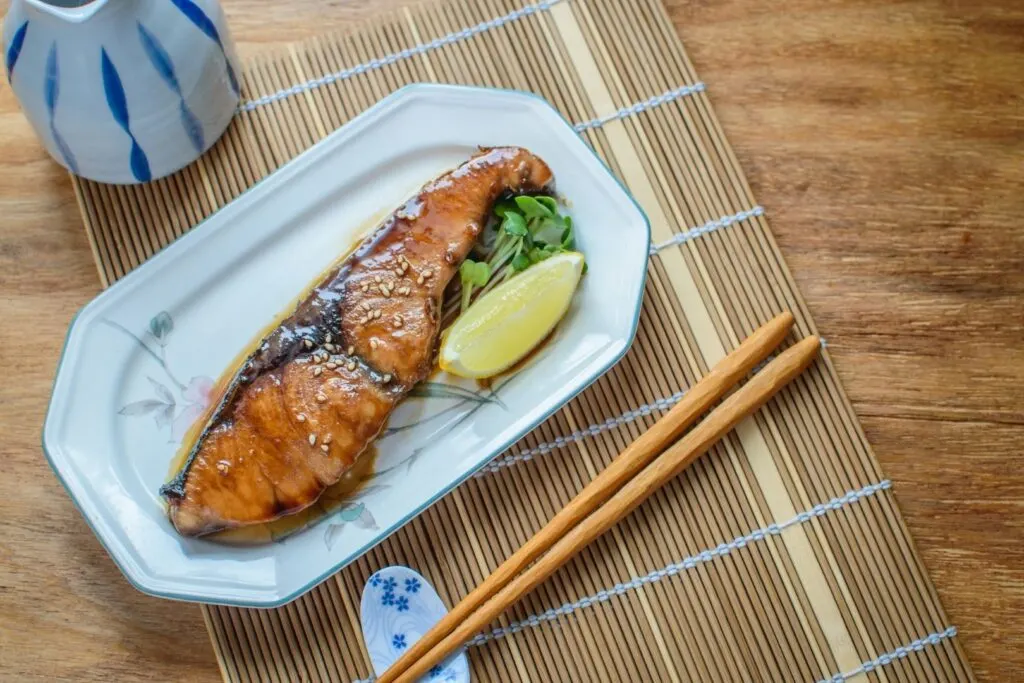
Teriyaki Chicken
Teriyaki Chicken (made with soy sauce and mirin).
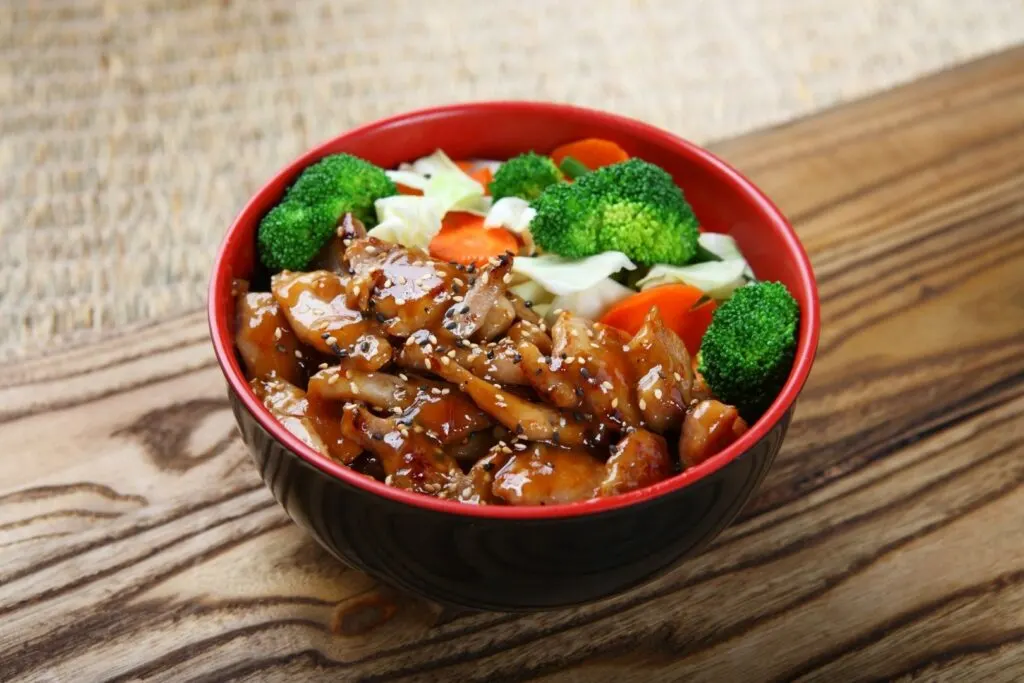
Unagi (eel)
Unagi sauce is made with soy sauce, sake, mirin, and sugar (same ratio).
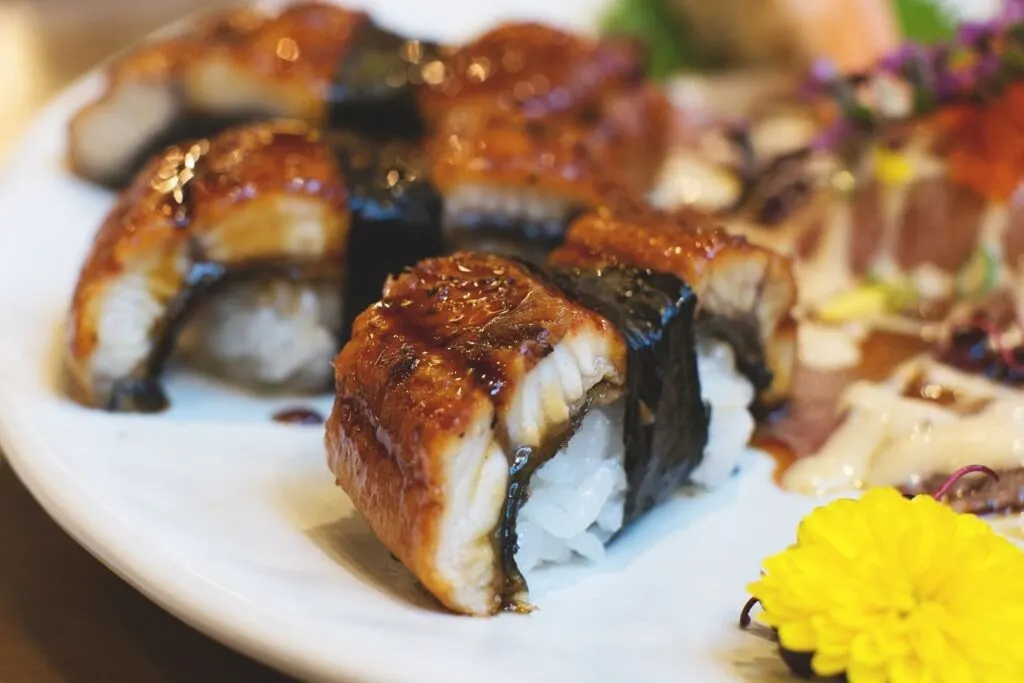
Nikujaga
Beef and vegetables cooked with dashi broth, sugar, mirin and soy sauce.
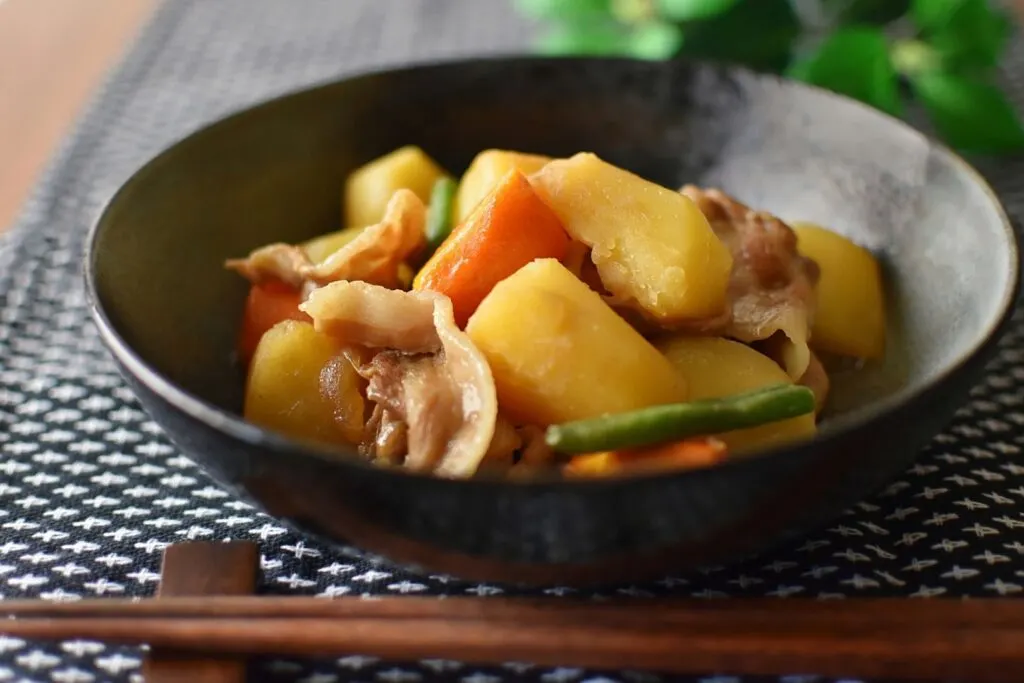
Mirin used in Cultural Celebrations and around Japan
During the New Year holiday in Japan, we celebrate with O-toso, a herbal alcohol drink made using either mirin or sake.
I remember having O-toso made with mirin as a little child and wondering what this deliciously sweet drink was. Of course, it is not good to drink alcohol from childhood but we were allowed to have a sip of O-toso for the New Year celebration. Read more about Otoso and how to make it here.
Shirozake is a mirin-based beverage made especially for celebrating Hina Matsuri (Girls’ Day) on March 3rd. It is made with Mirin and ground Koji rice that has been fermented for a month, resulting in a sweet white drink.
Another product that is used like Hon Mirin, but made differently, is Akazake (赤酒, あかざけ) from Kumamoto prefecture on the southern island of Kyushu. It is made similarly to how sake is made (brewed with parallel fermentation) but wood ash is added to prevent it from getting acidified.
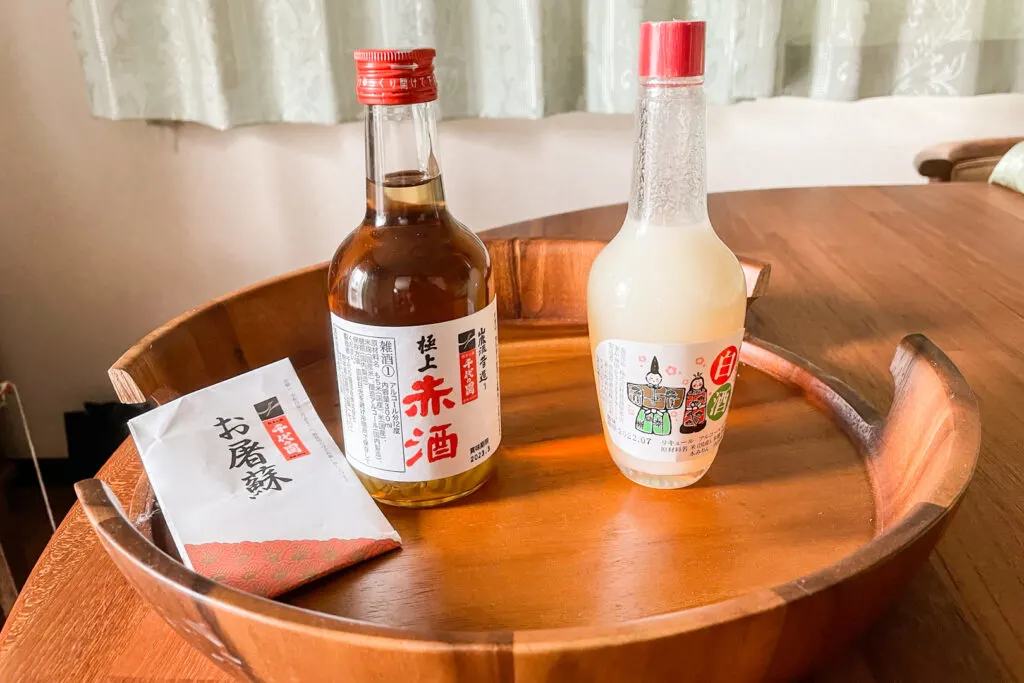
History of Mirin in Japan
There are many theories about the origins of Hon Mirin, but in the Sengoku period (1467-1615), it was used as a sweet drinking sake by women and people who could not drink nihonshu (Japanese sake).
Like many customs of the time, Hon Mirin was first enjoyed by the aristocratic class before it filtered down to the general public. It was in the late Edo period (mid 1800s) that it began to be used as a seasoning – the popular dishes at the time using it were Unagi sauce and soba dipping sauce – and the practice was solidified in the Showa period (1926-1989) when it became a mainstay of modern Japanese cooking. Since 1955, it has been widely used at home as a sweet condiment.
Since then, the mirin industry has gone from strength to strength. According to the National Tax Agency’s 2020 report, the consumption of Hon Mirin grew three times compared to 1970, while sake diminished to one-third over the same period.
In the most recent report, the current number of mirin producers is 67 with only 15 of them making mirin as their main or their only product. If you take a look at the number of sake breweries, there are 1235 sake producers (in the 清酒 sake category) and among them, 1130 have registered sake as their main product and are sake breweries.
However, despite the big difference in the number of mirin producers versus sake producers, the total gross annual sale amount of 1110 sake breweries was 356 million yen (on alcohol) or around US$3.035 million, while 13 mirin producers had total Hon Mirin sales of 1051 million yen (US$8.9 million). Obviously, in Japan, mirin is selling at a much higher rate than sake.
Drinking-level Mirin
Since mirin is categorized as a condiment, not many people know that there is drinkable Hon Mirin as well as non-drinkable Hon Mirin.
Here is a selection of delicious Hon Mirin products that are drinking level.
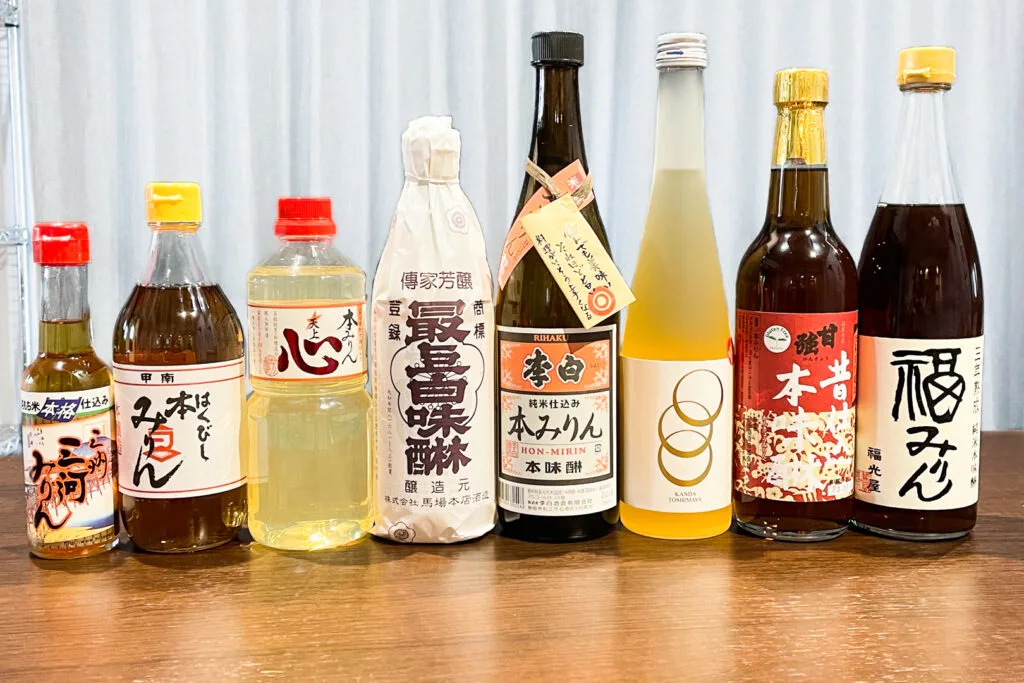
The aged ones are brown and have a mild sweetness. They have a rich and thick texture with a chocolate-ish nose. In a sommelier tasting, we enjoyed having brown-colored aged ones to pour over vanilla ice cream more than the white Hon Mirin since it has more character.
Overall after the tasting with fellow sommeliers, we picked the best Hon Mirin and here are the two which exceeded in the grading categories over the others.
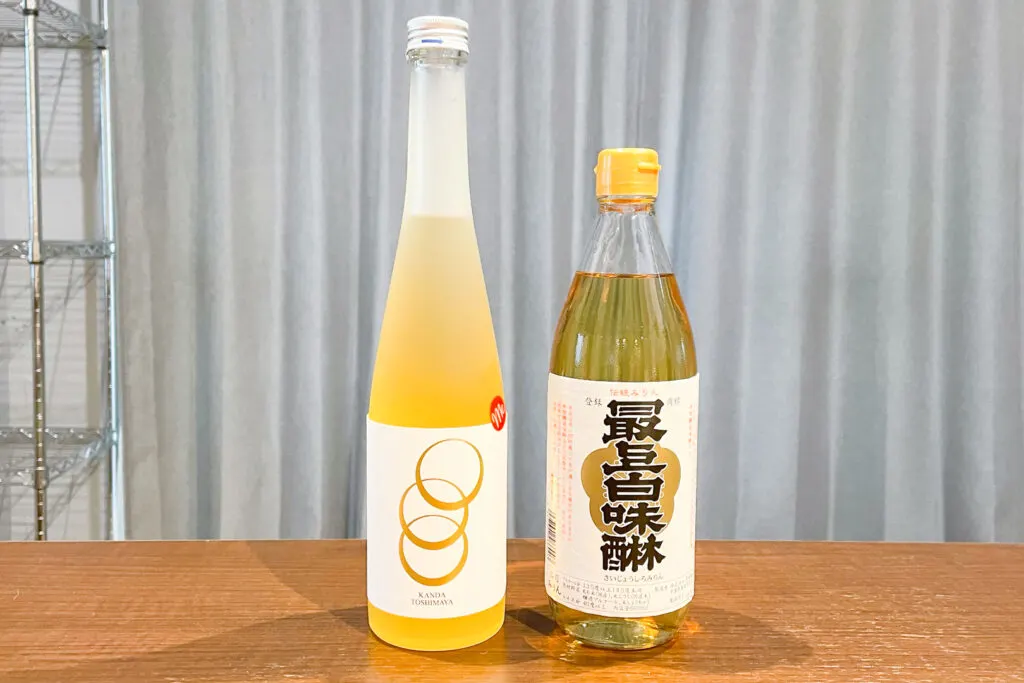
On the left is Me by Toshimaya Shuzo in Tokyo. Absolutely fantastic. It is unpasteurized Hon Mirin. It has a very elegant sweetness and is best to drink instead of using it in cooking.
Saijo Shiromirin on the right is Hon Mirin made by Baba Honten Shuzo in Chiba. Although Saijo Shiromirin uses both Shochu and Jozo (brewer’s) alcohol in the making, the taste is very elegant. Price-wise, it’s not as expensive compared to Me. It can be used in drinking (making cocktails) and cooking.
Simple cocktails using Hon Mirin
Yes, cocktails are an excellent way to enjoy mirin as a beverage. Here are a couple of easy cocktails you can make using Hon Mirin.
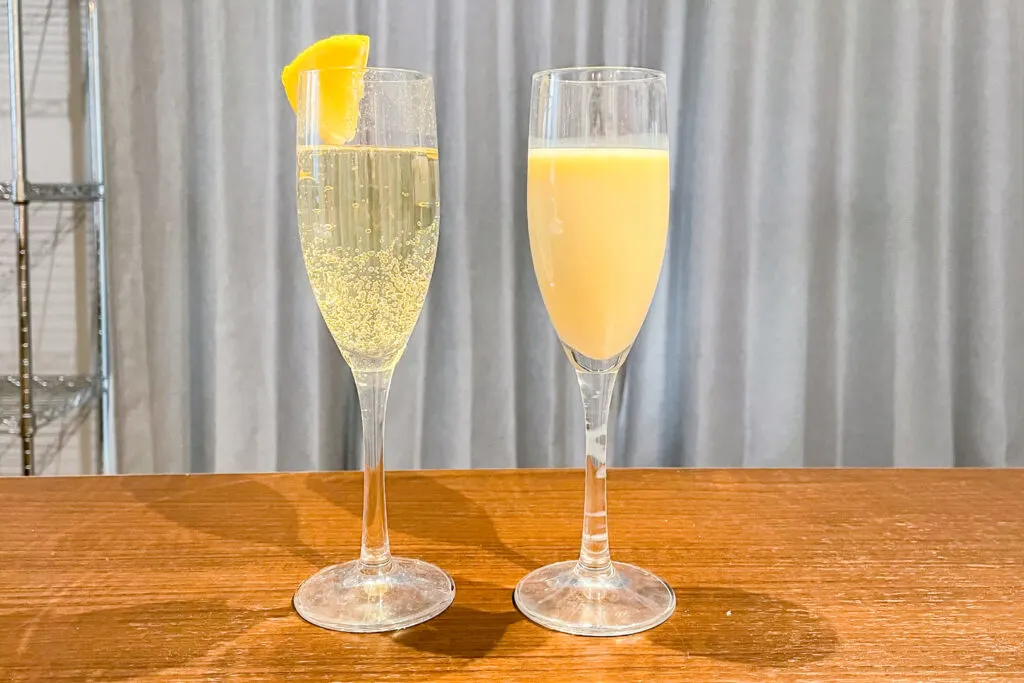
On the left is a refreshing, citrusy cocktail made with Hon Mirin, soda water and a squeeze of lemon juice. Adjust the ratio to taste.
The one on the right is aged Hon Mirin with soy milk for a Kahlua milk-esque beverage. I personally love soy milk, but you can switch it out for regular dairy milk if you prefer it (and will give a thicker, milky taste most similar to that of Kahlua milk). The ratio of Hon Mirin to milk is one to one, but you can adjust the amount of mirin depending on your preferred sweetness level.
Using mirin as a sugar replacement/sweetener
Besides using it in traditional Japanese cooking, mirin can be used in other instances where a sweetener is required.
If you make Nikiri Mirin (煮切り味醂, にきり・みりん, thoroughly boiled mirin) to remove the alcohol first, it can be useful in many ways. I like to use it to replace white sugar when making fresh cream caramel and cheesecake. It can also be used like honey or maple syrup, such as drizzled over yogurt or ice cream.
Remember not to overcook Hon Mirin. Cooking mirin on its own for more than 8 minutes will likely result in a darker brown color and it will be stiff when it gets cold. (It will be like hard candy.)
When using Hon Mirin (or Nikiri Mirin) in place of solid sugar, you won’t get the same sweetness level. The taste of Nikiri Mirin is similar to agave syrup. It will be more of a mild sweetness, perhaps less than half or one third of cakes using white sugar.
Think of it like adding water to dilute sugar. White sugar is 100% sugar but 40% of Hon Mirin is extract (meaning 60% is like water) so even if you double the amount of Hon Mirin, it will still only be about 80% of the sweetness level you would have had if you used white sugar. If adding Hon Mirin in baking, I personally avoid adding other sugars to benefit from the low GI of the mirin.
What I usually do is if the recipe book says 50g sugar, I might add 100g Hon Mirin then dissolve some sake kasu in it over low heat and put it in my cake mixture. The amount of time required to dissolve the sake kasu in the mirin will vary depending on the firmness of the sake kasu used, but you should limit it as much as possible so that you are not cooking out any desirable traits from the sake kasu, such as fruity aromas.
It may only take a minute for softer sake kasu but 3-5 minutes for harder sheets. If only cooking for a minute, you may want to start with Nikiri Mirin because otherwise there won’t be enough time to cook out the alcohol.
Also keep in mind the temperature of the mixture before adding it to your baking. For example, a mix that has been cooked over low heat for a minute won’t be nearly as hot as one cooked for five minutes, so you should allow it to cool enough before adding it to ingredients like whipped eggs.
There are many recipes available through Cookpad and YouTube. Please explore using Hon Mirin in your cooking.
Where to buy Hon Mirin
Here is a Google Map I created of delicious Hon Mirin producers in Japan.
It excludes mass producers like Kikkoman, Honbo, and Takara who are using continuous distilled alcohol machines instead of using the traditional pot.
Quick guide and tips on what to buy
- Use Hon Mirin when you can, that which is made using Shochu is best. If not, Hon Mirin made from Jozo (brewer’s) alcohol is OK.
- If you want to make a cocktail, then always pick Hon Mirin that is made using the traditional method, with just glutinous rice, koji rice, and Shochu. Some producers call this Junmai Hon Mirin. (純米本みりん).
- If you are living overseas and can only find mass produced products like Kikkoman or Takara, then chose the one which has ingredients from and is made in Japan. There is Hon Mirin made in Vietnam and Thailand so check out the label carefully.
Pin me for later
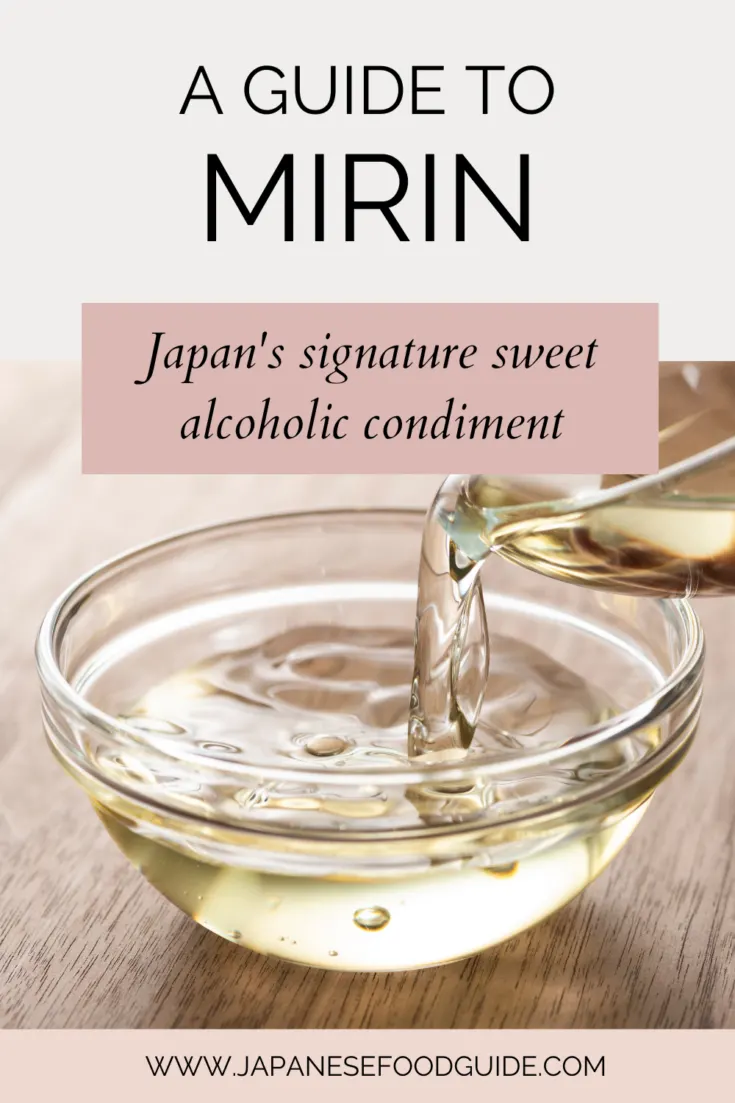
Kyoko Nagano is a serial entrepreneur and Michelin star restaurant enthusiast based in Kanagawa. As a Certified sake sommelier, fermented food sommelier, and tofu, inarizushi and soy oil meister, she is an expert on Japanese food and drink.
Kyoko has spent 17 years abroad in 4 countries, and is now on a mission in Japan to support small craft sake breweries and traditional cultural businesses to help them survive.

Andy Macaroon
Wednesday 19th of July 2023
I grew up in England, but my dad had Scottish roots, so from about 10 onwards we were given a wee dram of whisky at new year. Also I struggled to sleep sometimes as a child, so occasionally when I couldn't sleep, my mum would make me warm milk, sweetened with honey and a dash of whisky, and I'm talking here about a very young age, like 5 or 6. It was only a very small amount, like a teaspoonful, medicinal purposes I guess.
Marcus Pakiser
Friday 1st of April 2022
Thank you this is the best education on Mirin I have ever read Brilliant!!